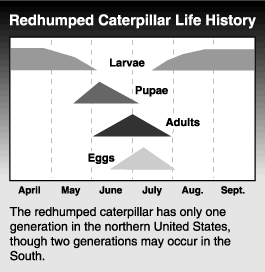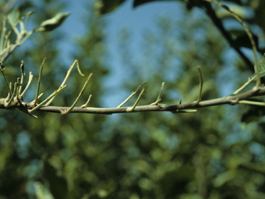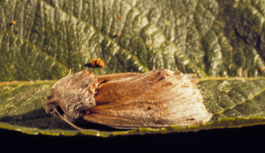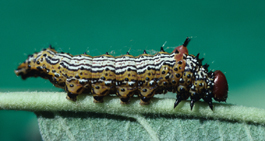by Jay F. Brunner, originally published 1993
Schizura concinna (J. E. Smith) (Lepidoptera: Notodontidae)
The redhumped caterpillar is found throughout the United States and Canada. Though not common in most orchards of the western United States, it is more often seen than the yellownecked caterpillar. In large numbers the caterpillars can severely defoliate trees.
Hosts
The redhumped caterpillar’s wide range of hosts includes apple, pear, cherry, plum, apricot, blackberry and many forest trees.
Life stages
Egg
The egg is pearly white and almost round but slightly flattened.
Larva
The fully grown larva is about 1 to 1-1/2 inches (25 to 35 mm) long. The head is a dull red, along with the hump on the first abdominal segment (just after the thorax, the reason for its common name. The body is a yellowish color with black and white stripes. There are black tubercles on the top of several body segments. When at rest, the larva will often raise its posterior tip.
Pupa
The pupa, a typical brown lepidopteran pupa, is found in a lightly woven cocoon under litter on the ground.
Adult
The adult redhumped caterpillar is an inconspicuous grayish brown moth.
Life history
 The redhumped caterpillar spends the winter as a full grown larva in a cocoon in the ground. It pupates in early summer and adult moths begin to emerge in June and July. Females lay eggs in clusters of 40 to 100 on the lower surfaces of leaves. Young larvae feed on the undersurfaces of leaves, but as they grow they consume entire leaves. Caterpillars from the same egg mass usually remain together on the same limb and feed in groups. They do not construct a tent or a nest. Caterpillars mature by August or September when they move to the ground and spin a cocoon under litter. The larvae remain in their cocoons during the winter. There is only one generation in the northern United States, though there may be two generations in the South.
The redhumped caterpillar spends the winter as a full grown larva in a cocoon in the ground. It pupates in early summer and adult moths begin to emerge in June and July. Females lay eggs in clusters of 40 to 100 on the lower surfaces of leaves. Young larvae feed on the undersurfaces of leaves, but as they grow they consume entire leaves. Caterpillars from the same egg mass usually remain together on the same limb and feed in groups. They do not construct a tent or a nest. Caterpillars mature by August or September when they move to the ground and spin a cocoon under litter. The larvae remain in their cocoons during the winter. There is only one generation in the northern United States, though there may be two generations in the South.
Damage
Larvae of the redhumped caterpillar can consume large quantities of foliage in a relatively short time when they are nearly full grown. They strip all the leaf, leaving only the mid-vein, and may strip several branches on a tree before maturing. They do not attack the fruit and are not usually a problem on larger trees but can completely defoliate a young tree.

Monitoring
The first sign of a redhumped caterpillar infestation is feeding damage. While few feeding sites are found in commercial fruit orchards, they may be more common in nurseries or orchards where few insecticides are used. Examine foliage for damage in late July or early August.
Biological control
Little is known about the potential for biological control of this pest. However, Ichneumonids in the genera Enicospilus and Aphanistes and Braconids in the genera Apanteles, Hypomicrogaster and Netelia are reported to attack it. In addition 10 species of Tachinids have been reared from it.
Management
Insecticides used to control other fruit pests will usually keep the redhumped caterpillar under control. Spot treatments with insecticides are also a viable option.


